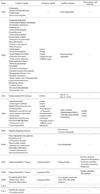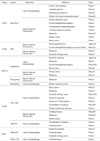Abstract
Toll-like receptors (TLRs) are pattern recognition receptors (PRRs) expressed in a wide spectrum of cell types that recognize distinctive ligands and subsequently activate adaptive immune responses. TLR ligands are considered a promising target for development of immunomodulatory agents. Extensive clinical investigations are currently underway to develop TLR ligands-based non-specific immunostimulants and vaccine adjuvants. It has been well accepted that cancer cells develop a strategy to avoid host immune responses by producing inhibitory molecules. In addition, tumor-associated antigens are often not strong enough to induce effective anti-cancer immune responses. In this context, immunostimulants or adjuvants are critically required for more effective cancer immunotherapies. Here, we discuss recent progresses in the field of cancer immunotherapy under special emphasis on the TLR ligands as a component of immunostimulatory agents.
Figures and Tables
References
1. Rosenberg SA, Yang JC, Restifo NP. Cancer immunotherapy: moving beyond current vaccines. Nat Med. 2004. 10:909–915.

2. Hedayat M, Takeda K, Rezaei N. Prophylactic and therapeutic implications of toll-like receptor ligands. Med Res Rev. 2012. 32:294–325.

4. Duthie MS, Windish HP, Fox CB, Reed SG. Use of defined TLR ligands as adjuvants within human vaccines. Immunol Rev. 2011. 239:178–196.

6. Goutagny N, Estornes Y, Hasan U, Lebecque S, Caux C. Targeting pattern recognition receptors in cancer immunotherapy. Target Oncol. 2012. 7:29–54.

7. Goutagny N, Fitzgerald KA. Pattern recognition receptors: an update. Expert Rev Clin Immunol. 2006. 2:569–583.

8. Akira S, Uematsu S, Takeuchi O. Pathogen recognition and innate immunity. Cell. 2006. 124:783–801.

9. Barber GN. Innate immune DNA sensing pathways: STING, AIMII and the regulation of interferon production and inflammatory responses. Curr Opin Immunol. 2011. 23:10–20.

10. Barton GM, Kagan JC. A cell biological view of Toll-like receptor function: regulation through compartmentalization. Nat Rev Immunol. 2009. 9:535–542.

11. Kono H, Rock KL. How dying cells alert the immune system to danger. Nat Rev Immunol. 2008. 8:279–289.

12. Coley WB. The treatment of malignant tumors by repeated inoculations of erysipelas. With a report of ten original cases. 1893. Clin Orthop Relat Res. 1991. 262:3–11.
13. Alexandroff AB, Jackson AM, O'Donnell MA, James K. BCG immunotherapy of bladder cancer: 20 years on. Lancet. 1999. 353:1689–1694.

14. Bsibsi M, Ravid R, Gveric D, van Noort JM. Broad expression of Toll-like receptors in the human central nervous system. J Neuropathol Exp Neurol. 2002. 61:1013–1021.

15. Gribar SC, Anand RJ, Sodhi CP, Hackam DJ. The role of epithelial Toll-like receptor signaling in the pathogenesis of intestinal inflammation. J Leukoc Biol. 2008. 83:493–498.

16. Alexopoulou L, Holt AC, Medzhitov R, Flavell RA. Recognition of double-stranded RNA and activation of NF-kappaB by Toll-like receptor 3. Nature. 2001. 413:732–738.

17. Jasani B, Navabi H, Adams M. Ampligen: a potential toll-like 3 receptor adjuvant for immunotherapy of cancer. Vaccine. 2009. 27:3401–3404.

18. Spranger S, Javorovic M, Bürdek M, Wilde S, Mosetter B, Tippmer S, et al. Generation of Th1-polarizing dendritic cells using the TLR7/8 agonist CL075. J Immunol. 2010. 185:738–747.

19. Roman M, Martin-Orozco E, Goodman JS, Nguyen MD, Sato Y, Ronaghy A, et al. Immunostimulatory DNA sequences function as T helper-1-promoting adjuvants. Nat Med. 1997. 3:849–854.

20. Vabulas RM, Pircher H, Lipford GB, Häcker H, Wagner H. CpG-DNA activates in vivo T cell epitope presenting dendritic cells to trigger protective antiviral cytotoxic T cell responses. J Immunol. 2000. 164:2372–2378.

21. O'Neill LA, Bryant CE, Doyle SL. Therapeutic targeting of Toll-like receptors for infectious and inflammatory diseases and cancer. Pharmacol Rev. 2009. 61:177–197.
22. Holtick U, Scheulen ME, von Bergwelt-Baildon MS, Weihrauch MR. Toll-like receptor 9 agonists as cancer therapeutics. Expert Opin Investig Drugs. 2011. 20:361–372.

24. Cai Z, Sanchez A, Shi Z, Zhang T, Liu M, Zhang D. Activation of Toll-like receptor 5 on breast cancer cells by flagellin suppresses cell proliferation and tumor growth. Cancer Res. 2011. 71:2466–2475.

25. Song EJ, Kang MJ, Kim YS, Kim SM, Lee SE, Kim CH, et al. Flagellin promotes the proliferation of gastric cancer cells via the Toll-like receptor 5. Int J Mol Med. 2011. 28:115–119.





 PDF
PDF ePub
ePub Citation
Citation Print
Print




 XML Download
XML Download